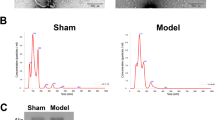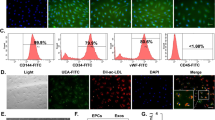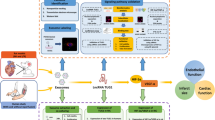Abstract
Objective
To investigate the involvement of endothelial cells (ECs)-derived exosomes in the anti-apoptotic effect of Danhong Injection (DHI) and the mechanism of DHI-induced exosomal protection against postinfarction myocardial apoptosis.
Methods
A mouse permanent myocardial infarction (MI) model was established, followed by a 14-day daily treatment with DHI, DHI plus GW4869 (an exosomal inhibitor), or saline. Phosphate-buffered saline (PBS)-induced ECs-derived exosomes were isolated, analyzed by miRNA microarray and validated by droplet digital polymerase chain reaction (ddPCR). The exosomes induced by DHI (DHI-exo), PBS (PBS-exo), or DHI+GW4869 (GW-exo) were isolated and injected into the peri-infarct zone following MI. The protective effects of DHI and DHI-exo on MI hearts were measured by echocardiography, Masson’s trichrome staining, and TUNEL apoptosis assay. The Western blotting and quantitative reverse transcription PCR (qRT-PCR) were used to evaluate the expression levels of miR-125b/p53-mediated pathway components, including miR-125b, p53, Bak, Bax, and caspase-3 activities.
Results
DHI significantly improved cardiac function and reduced infarct size in MI mice (P<0.01), which was abolished by the GW4869 intervention. DHI promoted the exosomal secretion in ECs (P<0.01). According to the results of exosomal miRNA microarray assay, 30 differentially expressed miRNAs in the DHI-exo were identified (28 up-regulated miRNAs and 2 down-regulated miRNAs). Among them, DHI significantly elevated miR-125b level in DHI-exo and DHI-treated ECs, a recognized apoptotic inhibitor impeding p53 signaling (P<0.05). Remarkably, treatment with DHI and DHI-exo attenuated apoptosis, elevated miR-125b expression level, inhibited capsase-3 activity, and down-regulated the expression levels of proapoptotic effectors (p53, Bak, and Bax) in post-MI hearts, whereas these effects were blocked by GW4869 (P<0.05 or P<0.01).
Conclusion
DHI and DHI-induced exosomes inhibited apoptosis, promoted the miR-125b expression level, and regulated the p53 apoptotic pathway in post-infarction myocardium.
Similar content being viewed by others
References
Roth GA, Mensah GA, Fuster V. The global burden of cardiovascular diseases and risks: a compass for global action. J Am Coll Cardiol 2020;76:2980–2981.
Bauersachs J. Heart failure drug treatment: the fantastic four. Eur Heart J 2021;42:681–683.
Huang W, Zhang Q, Qi H, Shi P, Song C, Liu Y, et al. Deletion of neuropeptide Y attenuates cardiac dysfunction and apoptosis during acute myocardial infarction. Front Pharmacol 2019;10:1268.
Huang W, Tian SS, Hang PZ, Sun C, Guo J, Du ZM. Combination of microRNA-21 and microRNA-146a attenuates cardiac dysfunction and apoptosis during acute myocardial infarction in mice. Mol Ther Nucleic Acids 2016;5:e296.
Nguyen BY, Azam T, Wang X. Cellular signaling cross-talk between different cardiac cell populations: an insight into the role of exosomes in the heart diseases and therapy. Am J Physiol Heart Circ Physiol 2021;320:H1213–H1234.
Lindenbergh M, Stoorvogel W. Antigen presentation by extracellular vesicles from professional antigen-presenting cells. Annu Rev Immunol 2018;36:435–459.
Gao XF, Wang ZM, Wang F, Gu Y, Zhang JJ, Chen SL. Exosomes in coronary artery disease. Int J Biol Sci 2019;15:2461–2470.
Lin X, He Y, Hou X, Zhang Z, Wang R, Wu Q. Endothelial cells can regulate smooth muscle cells in contractile phenotype through the miR-206/ARF6&NCX1/exosome axis. PLoS One 2016;11:e0152959.
Su Q, Lv XW, Xu YL, Cai RP, Dai RX, Yang XH, et al. Exosomal LINC00174 derived from vascular endothelial cells attenuates myocardial I/R injury via p53-mediated autophagy and apoptosis. Mol Ther Nucleic Acids 2021;23:1304–1322.
Asgarpour K, Shojaei Z, Amiri F, Ai J, Mahjoubin-Tehran M, Ghasemi F, et al. Exosomal microRNAs derived from mesenchymal stem cells: cell-to-cell messages. Cell Commun Signal 2020;18:149.
Song WP, Gu SJ, Tan XH, Gu YY, Song WD, Zeng JY, et al. Proteomic analysis and miRNA profiling of human testicular endothelial cell-derived exosomes: the potential effects on spermatogenesis. Asian J Androl 2022;24:478–486.
Feng X, Li Y, Wang Y, Li L, Little PJ, Xu SW, et al. Danhong injection in cardiovascular and cerebrovascular diseases: pharmacological actions, molecular mechanisms, and therapeutic potential. Pharmacol Res 2019;139:62–75.
Li JP, Liu Y, Guo JM, Shang EX, Zhu ZH, Zhu KY, et al. A comprehensive strategy to evaluate compatible stability of Chinese medicine injection and infusion solutions based on chemical analysis and bioactivity assay. Front Pharmacol 2017;8:833.
Zhang J, Shi X, Gao J, Zhou R, Guo F, Zhang Y, et al. Danhong Injection and trimetazidine protect cardiomyocytes and enhance calcium handling after myocardial infarction. Evid Based Complement Alternat Med 2021;2021:2480465.
Zhang X, Wang H, Chang Y, Wang Y, Lei X, Fu S, et al. An Overview of meta-analyses of Danhong Injection for unstable angina. Evid Based Complement Alternat Med 2015;2015:358028.
Chen J, Wei J, Orgah J, Zhu Y, Ni J, Li L, et al. Cardioprotective effect of Danhong Injection against myocardial infarction in rats is critically contributed by microRNAs. Evid Based Complement Alternat Med 2019;2019:4538985.
Li S, Li P, Liu W, Shang J, Qiu S, Li X, et al. Danhong Injection alleviates cardiac fibrosis via preventing the hypermethylation of Rasal1 and Rassf1 in TAC mice. Oxid Med Cell Longev 2020;2020:3158108.
Li SN, Li P, Liu WH, Shang JJ, Qiu SL, Zhou MX, et al. Danhong Injection enhances angiogenesis after myocardial infarction by activating MiR-126/ERK/VEGF pathway. Biomed Pharmacother 2019;120:109538.
Gao E, Lei YH, Shang X, Huang ZM, Zuo L, Boucher M, et al. A novel and efficient model of coronary artery ligation and myocardial infarction in the mouse. Circ Res 2010;107:1445–1453.
Tabatadze N, Savonenko A, Song H, Bandaru VV, Chu M, Haughey NJ. Inhibition of neutral sphingomyelinase-2 perturbs brain sphingolipid balance and spatial memory in mice. J Neurosci Res 2010;88:2940–2951.
Wu J, Gu J, Shen L, Fang D, Zou X, Cao Y, et al. Exosomal MicroRNA-155 inhibits enterovirus A71 infection by targeting PICALM. Int J Biol Sci 2019;15:2925–2935.
Tian Y, Gong M, Hu Y, Liu H, Zhang W, Zhang M, et al. Quality and efficiency assessment of six extracellular vesicle isolation methods by nano-flow cytometry. J Extracell Vesicles 2020;9:1697028.
Cho SM, Shin S, Kim Y, Song W, Hong SG, Jeong SH, et al. A novel approach for tuberculosis diagnosis using exosomal DNA and droplet digital PCR. Clin Microbiol Infect 2020;26:942.e1–942.e5.
Feng Q, Li Q, Zhou H, Sun L, Lin C, Jin Y, et al. The role of major immune cells in myocardial infarction. Front Immunol 2022;13:1084460.
Jiang X, Lv B, Li P, Ma X, Wang T, Zhou Q, et al. Bioactivity-integrated UPLC/Q-TOF-MS of Danhong Injection to identify NF- κ B inhibitors and anti-inflammatory targets based on endothelial cell culture and network pharmacology. J Ethnopharmacol 2015;174:270–276.
Zhang Q, Wang L, Wang S, Cheng H, Xu L, Pei G, et al. Signaling pathways and targeted therapy for myocardial infarction. Signal Transduct Target Ther 2022;7:78.
Lai N, Jayaraman A, Lee K. Enhanced proliferation of human umbilical vein endothelial cells and differentiation of 3T3-L1 adipocytes in coculture. Tissue Eng Part A 2009;15:1053–1061.
Kwon JS, Kim YS, Cho AS, Cho HH, Kim JS, Hong MH, et al. Regulation of MMP/TIMP by HUVEC transplantation attenuates ventricular remodeling in response to myocardial infarction. Life Sci 2014;101:15–26.
Alam P, Maliken BD, Jones SM, Ivey MJ, Wu Z, Wang Y, et al. Cardiac remodeling and repair: recent approaches, advancements, and future perspective. Int J Mol Sci 2021;22:13104
Liu W, Feng Y, Wang X, Ding J, Li H, Guan H, et al. Human umbilical vein endothelial cells-derived exosomes enhance cardiac function after acute myocardial infarction by activating the PI3K/AKT signaling pathway. Bioengineered 2022;13:8850–8865.
Barile L, Lionetti V, Cervio E, Matteucci M, Gherghiceanu M, Popescu LM, et al. Extracellular vesicles from human cardiac progenitor cells inhibit cardiomyocyte apoptosis and improve cardiac function after myocardial infarction. Cardiovasc Res 2014;103:530–541.
Chao CT, Yeh HY, Yuan TH, Chiang CK, Chen HW. MicroRNA-125b in vascular diseases: an updated systematic review of pathogenetic implications and clinical applications. J Cell Mol Med 2019;23:5884–5894.
Zhu LP, Tian T, Wang JY, He JN, Chen T, Pan M, et al. Hypoxia-elicited mesenchymal stem cell-derived exosomes facilitates cardiac repair through miR-125b-mediated prevention of cell death in myocardial infarction. Theranostics 2018;8:6163–6177.
Wang X, Ha T, Zou J, Ren D, Liu L, Zhang X, et al. MicroRNA-125b protects against myocardial ischemia/reperfusion injury via targeting p53-mediated apoptotic signaling and TRAF6. Cardiovasc Res 2014;102:385–395.
Li Q, Wu Y, Zhang Y, Sun H, Lu Z, Du K, et al. miR-125b regulates cell progression in chronic myeloid leukemia via targeting BAK1. Am J Transl Res 2016;8:447–459.
Ruan XF, Ju CW, Shen Y, Liu YT, Kim IM, Yu H, et al. Suxiao Jiuxin Pill promotes exosome secretion from mouse cardiac mesenchymal stem cells in vitro. Acta Pharmacol Sin 2018;39:569–578.
Yang J, Gao F, Zhang Y, Liu Y, Zhang D. Buyang Huanwu Decoction enhances angiogenic effect of mesenchymal stem cell by upregulating VEGF expression after focal cerebral ischemia. J Mol Neurosci 2015;56:898–906.
Colombo M, Moita C, van Niel G, Kowal J, Vigneron J, Benaroch P, et al. Analysis of ESCRT functions in exosome biogenesis, composition and secretion highlights the heterogeneity of extracellular vesicles. J Cell Sci 2013;126:5553–5565.
Mittelbrunn M, Gutiérrez-Vázquez C, Villarroya-Beltri C, González S, Sánchez-Cabo F, González MÁ, et al. Unidirectional transfer of microRNA-loaded exosomes from T cells to antigen-presenting cells. Nat Commun 2011;2:282.
Author information
Authors and Affiliations
Contributions
Li SN and Xing WL equally contributed to this work as co-first author. Liu HX made substantial contributions to the conception or design of the work. Li SN and Xing WL made contributions to the acquisition, analysis or interpretation of data for this work and drafted the work. Liu ZH, Zhou MX, LIU WH, Lai XL, Li P, and Zhang L made contributions to the data analysis in Western blot and RT-PCR. Shang JJ, Qiu SL, Lou Y, and Tan YP revised the work for important intellectual content. All authors have agreed with the content and approve of the manuscript for submission.
Corresponding author
Ethics declarations
The authors declare that there are no conflicts of interest regarding the publication of this paper.
Additional information
Supported by National Natural Science Foundation of China (No. 82174106 and No. 81703850)
Supplementary Materials
11655_2023_3647_MOESM1_ESM.pdf
Appendix 1. Total ion chromatograms of DHI in positive (A) and negative ion mode (B) based on UPLC-TOF MS. P1: Protocatechualdehyde; P2: Salvianolic acid D; P3: Kaempferide; P4: Salvianolic acid A; P5: Coumalic acid; P6: Rosmarinic acid; P7: Salvianolic acid B.
Rights and permissions
About this article
Cite this article
Li, Sn., Liu, Zh., Zhou, Mx. et al. Danhong Injection Up-regulates miR-125b in Endothelial Exosomes and Attenuates Apoptosis in Post-Infarction Myocardium. Chin. J. Integr. Med. 29, 1099–1110 (2023). https://doi.org/10.1007/s11655-023-3647-7
Accepted:
Published:
Issue Date:
DOI: https://doi.org/10.1007/s11655-023-3647-7




